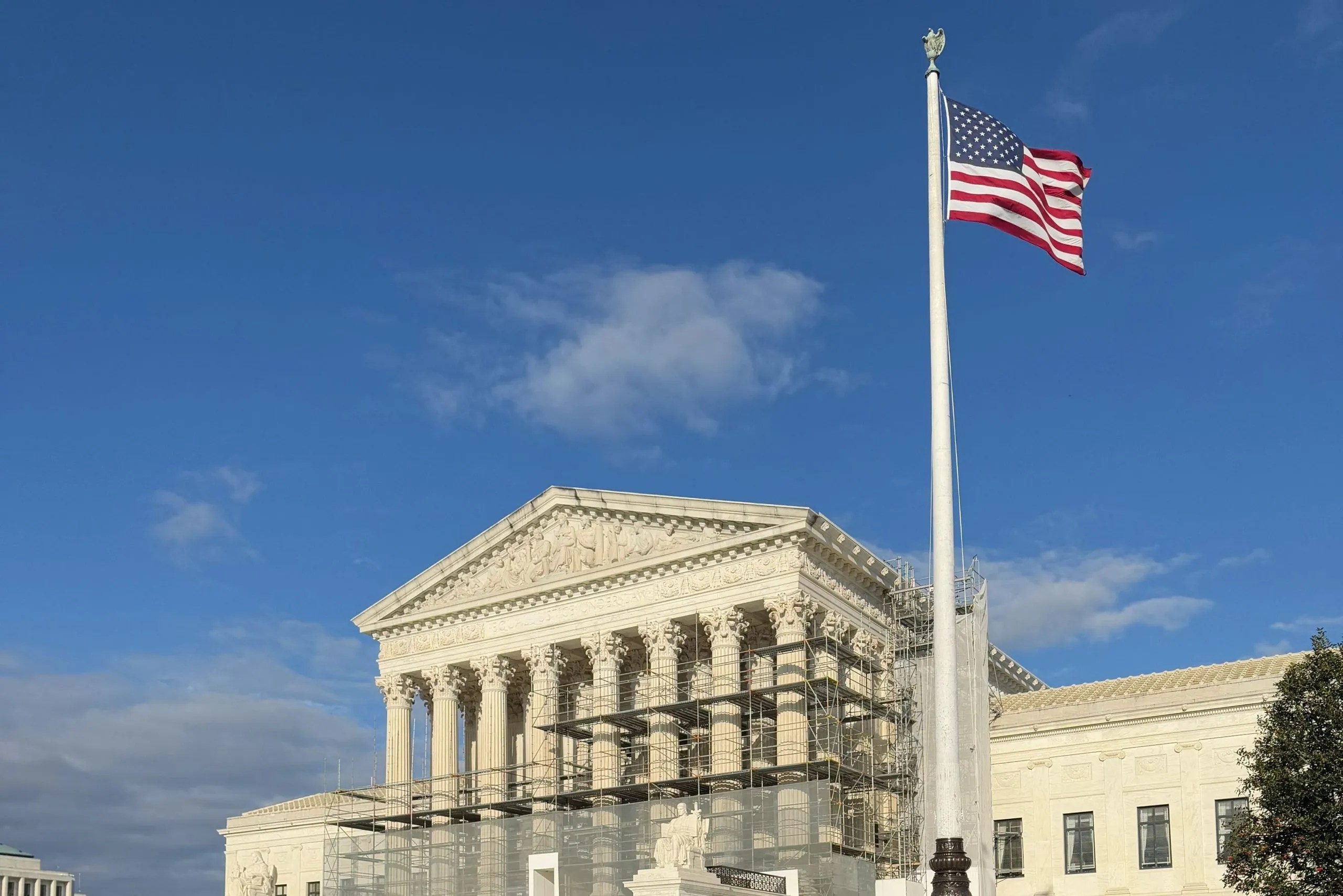The Supreme Court and flag burning: an explainer


President Donald Trump wants to prosecute flag burning, but can he make that happen without violating Supreme Court precedent? Trump contends it’s possible in an Aug. 25 executive order that instructs the attorney general to consider litigation that would “clarify the scope of the First Amendment exceptions in this area.”
Specifically, Trump’s order puts a spotlight on the court’s 1989 ruling in Texas v. Johnson, raising questions about possible loopholes in that case’s defense of flag desecration under the Constitution and about whether current justices would stand by their predecessors’ conclusions.
Here’s a brief explainer on free speech, flag burning, and what former Justice Antonin Scalia said he would do about flag desecration if he were king.
What does the executive order on flag burning say?
The order, titled Prosecuting Burning of the American Flag, describes the significance of the American flag and why it’s offensive to destroy it. Burning it “may incite violence and riot,” it says, and the pursuit of that outcome should be punished.
“Notwithstanding the Supreme Court’s rulings on First Amendment protections, the Court has never held that American Flag desecration conducted in a manner that is likely to incite imminent lawless action or that is an action amounting to ‘fighting words’ is constitutionally protected,” Trump contends.
The order goes on to instruct the attorney general to prosecute – using existing laws on property damage, discrimination, hate crimes, and other forms of violence – instances of flag burning that cause “harm unrelated to expression, consistent with the First Amendment.”
The order also instructs the attorney general, secretary of state, and secretary of homeland security to “deny, prohibit, terminate, or revoke visas, residence permits, naturalization proceedings, and other immigration benefits” whenever they determine that “foreign nationals have engaged in American Flag-desecration activity under circumstances that permit the exercise of such remedies pursuant to Federal law.”
How did legal experts react to the flag burning order?
Trump’s executive order on flag burning was met with immediate pushback. Many legal experts said it runs afoul of Supreme Court precedent, not just on flag desecration but on free speech in general.
For example, Eugene Volokh argued that, although the order doesn’t ban all flag burning, it encourages “selective enforcement” of otherwise neutral laws regarding public fires and government property by telling federal authorities to “prioritize” the enforcement of those laws against people who desecrate the American flag. Such selective enforcement amounts to unlawful targeting of protected speech, he wrote.
However, administration officials were clearly ready for criticism. In their public statements on the order, they have emphasized their belief that it’s possible to prosecute flag burning without violating free speech protections.
“Thank you for protecting the American flag, and we’ll do that without running afoul of the First Amendment,” said Attorney General Pam Bondi at the signing ceremony for the order.
So, what has the Supreme Court said about flag burning?
The Supreme Court addressed flag burning in the 1989 case of Texas v. Johnson. A 5-4 majority held that states cannot enact blanket bans on flag desecration because, under some circumstances, flag burning is a form of symbolic speech protected by the First Amendment.
The case stemmed from a flag burning that took place at a demonstration against the Reagan administration during the 1984 Republican National Convention in Dallas. After being handed a flag from one of his fellow protesters, Gregory Lee Johnson “doused it with kerosene, and set it on fire.” Several observers reported being “seriously offended” by his behavior, but no one was hurt “or threatened with injury.” Johnson was convicted of violating a Texas law regarding the desecration of a venerated object, sentenced to one year in prison, and fined $2,000.
Johnson appealed his conviction to the Texas Court of Criminal Appeals, the state’s highest court for criminal cases, which ruled in his favor, holding that the state’s effort to punish Johnson for flag burning violated the First Amendment. To achieve its stated goal of keeping the peace without violating free speech protections, the court said, Texas only needed to criminalize incidents that truly fueled violence, not flag burning in general.
Texas appealed that decision to the Supreme Court, which ultimately affirmed the state court’s decision. The Supreme Court’s opinion, released in June 1989, said that the First Amendment protects a variety of forms of expressive conduct, not just actual speech, and that flag burning can become one such protected form, as it did in Dallas.
“Johnson burned an American flag as part — indeed, as the culmination — of a political demonstration that coincided with the convening of the Republican Party and its renomination of Ronald Reagan for President. The expressive, overtly political nature of this conduct was both intentional and overwhelmingly apparent,” wrote Justice William Brennan for the majority, which included Scalia.
The fact that flag burning can be protected speech does not mean it always is, Brennan added, noting that states retain the power “to prevent ‘imminent lawless action.’” The court made it clear, however, that offending observers is not the same thing as promoting lawlessness.
In dissent, Chief Justice William Rehnquist rejected the majority’s interpretation of the First Amendment, arguing that Johnson had been punished for what he did to the flag, not for the message he was trying to convey. “For more than 200 years, the American flag has occupied a unique position as the symbol of our Nation, a uniqueness that justifies a governmental prohibition against flag burning,” he wrote.
Congress responded to the Johnson decision by criminalizing flag burning nationwide. The Flag Protection Act of 1989 outlawed mutilation, defacement, and other attacks on the American flag, while still allowing for the disposal of “worn or soiled” flags.
The Supreme Court took up a challenge to the 1989 law and heard arguments on it 11 months after releasing the Johnson decision. In United States v. Eichman, the same five-justice majority from Johnson again held that flag burning can be a protected form of speech, determining that prosecuting individuals who had set fire to American flags to protest the Flag Protection Act violated the First Amendment.
“[T]he Act still suffers from the same fundamental flaw: it suppresses expression out of concern for its likely communicative impact,” Brennan wrote for the court.
Where does the idea of Scalia as “king” come into this?
Those two 5-4 decisions did not settle the debate on criminalizing flag burning. Over the past 35 years, Congress has tried several times to add an anti-flag burning amendment to the Constitution, but none of the proposals got the support of two-thirds of the Senate, a bar that must be cleared before a constitutional amendment can make it through Congress.
Persistent interest in banning flag desecration helps explain why Scalia was sometimes asked during public appearances why he joined the Johnson majority. Excerpts from his responses circulated widely this week amid the discussion on Trump’s executive order.
“[I]f I were king, I would not allow people to go about burning the American flag. However, we have a First Amendment, which says that the right of free speech shall not be abridged. And it is addressed, in particular, to speech critical of the government,” Scalia said during a 2012 appearance on CNN.
He picked up the same refrain in 2015, during one of his last public events. “If it were up to me, I would put in jail every sandal-wearing, scruffy-bearded weirdo who burns the American flag,” he said, according to the National Constitution Center. “But I am not king.”
What are the Trump administration’s arguments?
Administration officials are well aware of the Supreme Court’s past rulings on flag burning and Scalia’s comments. They’ve referenced them while defending the new order.
“Few things: 1) Antonin Scalia was a great Supreme Court Justice and a genuinely kind and decent person. 2) The President’s EO is consistent with Texas v. Johnson. 3) Texas v. Johnson was wrong and William Rehnquist was right,” wrote Vice President JD Vance on X on Tuesday.
Vance and others in the administration contend that the order is constitutional because it takes aim at only those acts of flag burning that even the Johnson majority did not defend. Specifically, the order is aimed at flag burning “that is likely to incite imminent lawless action” or which amounts to “fighting words,” words that are sufficiently offensive to provoke an average person to violently retaliate. In Johnson, the court said such expressive conduct is not entitled to the same protections as speech that merely causes offense.
But it remains to be seen whether it’s possible to draw clear distinctions between different acts of flag burning, classifying some as “fighting words” and others as protected forms of speech. In the 1989 case, Texas argued that prosecuting Johnson was part of keeping the peace, but the court looked at the same set of circumstances and said that peace was never at risk, since causing offense is not the same thing as disturbing the peace.
When will this come to a head?
As noted above, Trump’s order does not impose a new national ban on flag burning but instead encourages Bondi and others to prosecute flag burners under existing laws, such as laws prohibiting fires in fire safety zones.
One such law, a prohibition on lighting a fire in a public park, led to the arrest of a man on Monday who burned an American flag across the street from the White House while protesting against Trump, according to NBC News. The man will almost certainly use the First Amendment to fight the charge as he continues to protest the new executive order.
And the Trump administration is unlikely to mind that development. As previously noted, administration officials have expressed interest in getting the issue of flag burning back in front of the justices in the hope that they will clarify or overturn the court’s previous rulings.
Posted in Court Analysis, Explainer